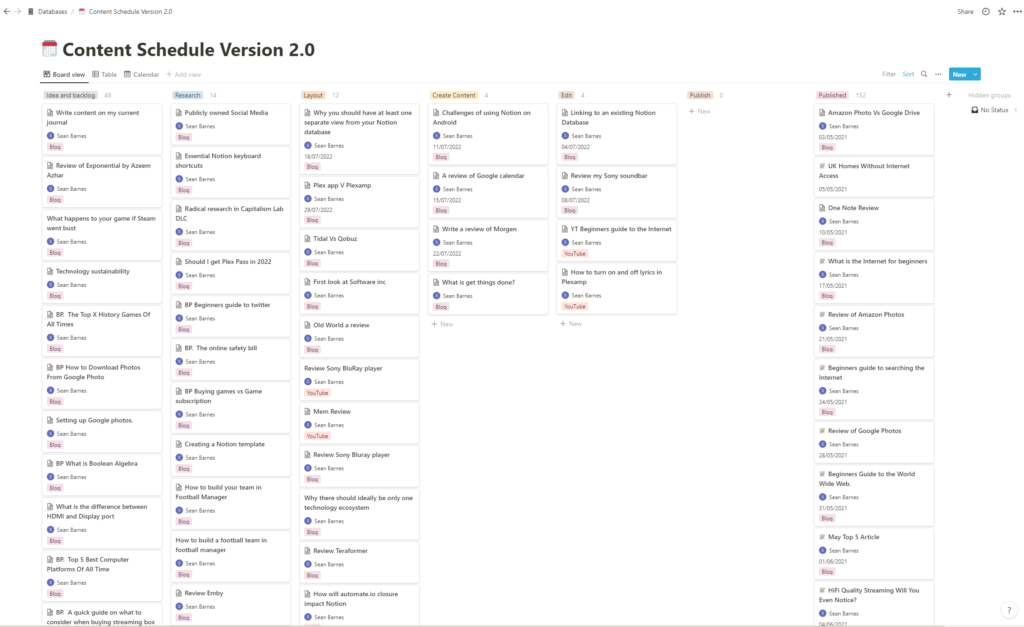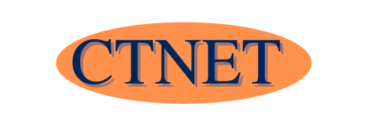In this blog post, I’ll share my productivity and knowledge management system for 2024. You can read my Productivity and Knowledge Management System 2023 post to see how it has evolved over the last year.
I consider my productivity and Knowledge Management Systems to be one. My Knowledge Management System can impact my productivity system, and my productivity system can impact my knowledge system.
My Productivity System Overview 2024
In 2024, my Productivity system is managed by two applications, Notion and Sunsama.
My Notion setup is based on many of David Allen’s concepts of Get Things Done. It is currently the home of Notion lists for ideas, projects, and tasks. I also use it to track a few goals for things that are important to me.
I also use it to manage my content schedule for the content I write here on CTNET and occasionally on Medium, as well as any other content I’m working on. I use it to track the journey of my content from the initial idea to published content.

As you can see, my content planner is displayed in a Kanban view, which makes it quite clear where my content is currently in my process.
I also track my progress weekly, monthly, and annually, which is currently recorded in Notion.
I pull my tasks and content creation into Sunsama, which I use to manage my tasks. In my guide on how to get started with Sunsama, I cover how I use Sunsama in greater detail.
I have just returned to using Obsidian to write the content I published. This very blog post was written in Obsidian.
My Knowledge Management System Overview 2024
My knowledge management system is far more complex than my productivity system, and I’m not sure that is really that surprising.
My knowledge management system has two objectives. First, it helps me turn information and ideas that I have consumed into knowledge, and second, it acts as an external extension of my memory.
At the heart of my knowledge management is Obsidian, which contains my Personal Knowledge Management system based on the Zettelkasten framework. It contains both literature and permanent notes. I have linked to related blog posts if you want to learn more about Zettelkasten.
My permanent notes contain backlinks to other relevant notes containing a wiki of my knowledge.
I keep a daily journal in my Obsidian vault to help me track the things I want to turn into habits and to remind me of important things, such as taking my medication. The journal will also contain anything that I have done that day that I consider to be worth remembering, as well as any notable ideas or thoughts I have had during that day.
My Productive and Knowledge Management system inputs
Previous productivity systems reviews would have called this part of the system an inbox, but I think it has become more complex than this, or at least I have a little more appreciation of how complex the inputs into my system have become.
Why don’t we take a look at the various inputs into my system.
In reality, not too much comes into my system this way, but it is an input that I look to check every day, as what does come in could become quite important.
Bullet Journal
As this is a technology blog, I’m not going to go into too much detail about my paper-based bullet journal. I use it to capture thoughts and ideas during the day, a bit like my journal in Obsidian. Its main advantage is that I can quickly capture ideas while I’m working on something else with little interruption to my flow. I have an article on Medium about how my bullet journal fits in with my digital system for you to read if you want to find out more.
Obsidian journal
I also keep a long-form journal in Obsidian, which, on occasion, provides input as I process my thoughts and ideas during the day.
Readwise Reader
Readwise Reader is a read-later application for capturing content you come across that you think you might want to read later. It uses the Readwise Reader web plugin.
As I read the content, any highlights and notes I take are brought into my Obsidian vault for later use via Readwise. This guide explains how I use Readwise Reader.
Kindal
Most of the nonfiction books I read are on my Kindle. Highlights and notes taken on Kindle e-books are imported into my Obsidian vault via Readwise.
Snipd
Snipd is a podcast application that makes it really easy to capture notes from podcasts that I’m listening to. All I have to do is press a single button on the Snipd application. For further information, I have linked to my Snipd review.
The notes created by Snipd are brought into my Obsidian vault via Readwise
Readwise
The Readwise application is the nerve centre for my Knowledge Management system. It pulls together my digital notes from multiple sources, which I can either access in Readwise itself or in Obsidian, as those notes are also synced with Obsidian.
You can learn more about Readwise in my review and I also have a guide on how to set up Readwise sync with Obsidian.
Processing the inputs into my system
As I process my various inputs, I consider where they sit in my system.
Notes and highlights passed through from Readwise
Once the notes have been fed into my Obsidian, they pass through a pipework of filters and processes. The first filter is to move my new notes to my shortlist folder highlighting. If the note isn’t worth highlighting, it’s copied to the Source material folder and is processed no further.
Once I have highlighted the note, it is passed onto the source material processing folder again. If I don’t consider processing the note any further, it is again moved to the source material folder.
The last step is to create my literature note from the source material. Once this has been done, the source note is moved to my source material. The new literature note goes to the processing literature note folder for further processing into my Zettelkasten.
Zettelkasten processing
This is hopefully the part of my process which turns the content I consume into usable knowledge.
The new literature note and its summarised notes will be used to create the permanent notes in my Zettelkasten. Each permanent note will link to other related notes, containing a web of information.
You can find out about the Zettelkasten process in my introductory guide to Zettelkasten.

Idea processing
At times, I get ideas that I might want to explore at some point in the future. These ideas will likely be captured in my bullet journal, from where they will be added to my ideas list, which I keep in Notion and assign a date view. Every Saturday, as part of my weekly review, I review these ideas and decide if I’m ready to start developing them, review them again at a future date, or whether that idea is still relevant.
The still relevant check is important as I have come across ideas that I have already done or that are no longer required.
Task management processing
As I work my way through my inputs, I generate things to do. This is tracked within my task list, which is hosted on Notion and brought into Sunsama to plan a time for me to do it. I recommend that you read my guide on using Sunsama and my Medium post on how my bullet journal fits in with my digital system.
Content creation processing
New content ideas are normally captured in my bullet journal, but I have also captured them when writing my longer journal. These ideas generate a new entry on my content schedule, which is kept in Notion.
For example, while laying out the idea for this post, I got the idea for a separate post on how to create a content schedule in Notion, which I wrote down in my bullet journal. I created a new content idea, and it was seated in my content schedule in the idea backlog column.
This section of my content schedule is reviewed every few months, and new ideas are moved to the research or layout columns.
The research column shows the content I think further research needs to be carried out on. This list is also reviewed regularly. Once I feel I’m ready to create content on that idea, it is moved to the layout column, which is the starting column for the content I’m creating.
Once the content has a layout status it can be brought into Sunsama for tracking and scheduling of the work. This post exists due to this process.
Conclusion
You should now have an idea of my own productivity and knowledge management system, which will continue to develop as I learn more about productivity and knowledge management and the digital systems available to me.
Hopefully, it will give you some ideas on how you can improve your own system. Let’s learn from each other.
